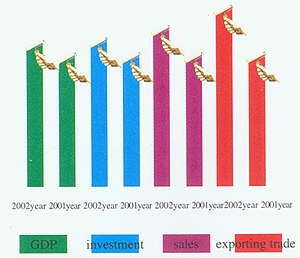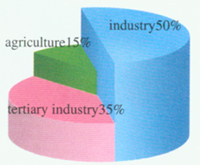|
Overview
(2004-09-04 15:05:14)
Since the implementation of the reforming and opening policy in China, Hubei has been keeping a rapid, sustainable and sound economic development. The economic structure has been adjusted and optimized, the comprehensive strength remarkably consolidated, and the status of Hubei's economy increasingly promoted. In recent years, the GDP of Hubei has maintained among the top ten positions in China. She is one of the provinces in China with the comparatively advanced economy.
The major economic index of Hubei Province in 2002: under the circumstance of the unstable world economy and disaster-stricken agriculture, total GDP of the Province amounted to 497.563 billion Yuan (RMB), which, calculated in terms of comparable prices, increased by 9.1% than that of tile previous year. The increasing rate exceeded that of the nation by hl percentage point. The total fix-asset investment was 169.5 billion Yuan (RMB), which increased by 9.2% than that of the previous year. The total volume of re- tail sales of the whole province was 219.842 yuan (RMB), increased by 11.3% than that of the previous year. The volume of exporting trade is $2.011 billion, increased by 16.8%. The disposable personal income of the residents in cities and towns throughout the province reached 6,800 Yuan (RMB). The personal net in- come of farmers was 2,444 Yuan (RMB). See the following table.

Hubei is an important agricultural province, a traditional industrial base and one of the new and high-tech industrial bases. The tertiary industries including tourism, business, finance, communications and transportation, post and telecommunications, building, etc, have also rapidly developed. A group of famous leading enterprises in Hubei have been listed at the Shanghai Stock Exchange and the Shenzhen Stock Exchange, which widens the financing channels and brings about a great advance in the expansion of enterprise scales and the development of Hubei's economy.
As for the economic Structure, the structural proportion between primary, secondary and tertiary industries tend to be rationalized. The agriculture, generally, makes up 15%, the industry 50% and the tertiary industry 35% or so. See the following table.

The major economic index of Hubei Province in 2002: under the circumstance of the unstable world economy and disaster-stricken agriculture, tile GDP of the Province amounted to 497.563 billion Yuan (RMB), which, calculated in terms of comparable prices, increased by 9.1% than that of tile previous year. The increasing rate exceeded that of the nation by hl percentage point. The total fix-asset investment was 169.5 billion Yuan (RMB), which increased by 9.2% than that of the previous year. The total volume of re- tail sales of the whole province was 219.842 yuan (RMB), increased by 11.3% than that of the previous year. The volume of exporting trade is $2.011 billion, increased by 16.8%. The disposable personal income of the residents in cities and towns throughout the province reached 6,800 Yuan (RMB). The personal net in- come of farmers was 2,444 Yuan (RMB).
|

